Blog categories
Blog archive
RSS Blog posts tagged with 'materials'
Blog Filters
Best Ecological Paint Solution for the Home
Friday, November 20, 2020
Graphenstone paints and coatings feature innovative qualities including thermal conductivity, greater toughness, flexibility, strength and uniformity, thanks to their advanced graphene technology. Renowned as the world’s first global manufacturer of the most advanced ecological mineral and natural paints, Graphenstone uses exclusive graphene technology featuring graphene fibres which provide excellent qualities including thermal conductivity, greater toughness, flexibility, strength and also acts as a structural support mesh at the molecular level of the paint. All these key features translate into greater durability and therefore lower maintenance, as well as very significant cost-savings. Ecological Paint with the Highest Certification
Graphenstone is the first paint in the world with the Cradle to Cradle’s GOLD Certificate, which is now the most demanding worldwide sustainable product certification. The brand also holds the Global Green Tag’s PLATINUM Health Rate Certification; the Eurofins VOC Emission’s Indoor Air Comfort GOLD Certification; the Australian Asthma Council’s APPROVED Sensitive Choice Certification as an asthma-friendly paint; and many other certifications throughout the world.
Ecological Paint with the Highest Certification
Graphenstone is the first paint in the world with the Cradle to Cradle’s GOLD Certificate, which is now the most demanding worldwide sustainable product certification. The brand also holds the Global Green Tag’s PLATINUM Health Rate Certification; the Eurofins VOC Emission’s Indoor Air Comfort GOLD Certification; the Australian Asthma Council’s APPROVED Sensitive Choice Certification as an asthma-friendly paint; and many other certifications throughout the world.
 Paint and Occupy at the Same Time
Graphenstone paints are odourless (free of strong and unpleasant synthetic chemical odours); free from VOCs and contain no solvents, formaldehyde or other toxic emissions; therefore, premises can be occupied when these paints are being applied. No paint odour will get into or remain in the centralised air-conditioning system; thus spaces can be occupied and used during or immediately after painting.
Cost-Savings Up to 20% Per Sqm
While Graphenstone offers a plethora of advantages and benefits compared to other premium products in the market, very significant cost-savings can still be achieved
Paint and Occupy at the Same Time
Graphenstone paints are odourless (free of strong and unpleasant synthetic chemical odours); free from VOCs and contain no solvents, formaldehyde or other toxic emissions; therefore, premises can be occupied when these paints are being applied. No paint odour will get into or remain in the centralised air-conditioning system; thus spaces can be occupied and used during or immediately after painting.
Cost-Savings Up to 20% Per Sqm
While Graphenstone offers a plethora of advantages and benefits compared to other premium products in the market, very significant cost-savings can still be achieved
For more details, please visit website: www.graphenstone.my; Facebook page: Graphenstone Malaysia or call Graphenstone/Buimaco Customer Care at +603 7885 0791(Mon-Fri, 9am-5pm)., Buimaco Ara Jaya Showroom at +6016 6626 101 (Mon-Sat, 9am-5pm) or Buimaco Subang Jaya Showroom at +6016 6626 085 (Mon-Sat, 9am-5pm)
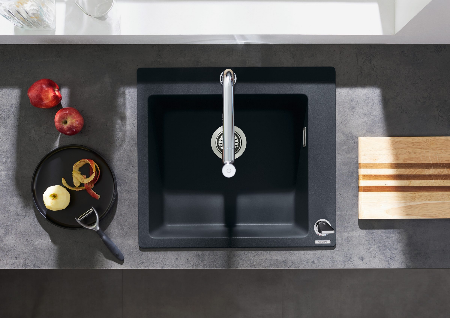
hansgrohe SilicaTec Kitchen Sinks Blend Form, Function and Exceptional Features into a Kitchen Masterpiece
Friday, November 20, 2020
The trend toward welcoming, open floor-plan kitchens is still going strong. Functional and equipped with state-of-the-art technology, open floor-plan kitchens blend harmoniously into the living environment and reflect the individuality and personality of the user. With its new SilicaTec granite range of kitchen sinks, the hansgrohe brand offers a comprehensive range for the kitchen centrepiece, combining a warm and welcoming look, elegant colours, premium design and long-lasting quality. hansgrohe SilicaTec Granite Sink 450
SilicaTec—a Quality Material for the Rigors of Everyday Kitchen Life
With SilicaTec, hansgrohe utilizes a composite made from quartz and acrylic resins, which has a natural look and is pleasing to the touch. But that’s not all it has to offer: only rounded quartz particles from quartz sand, the hardest constituent of granite, are processed. The result is a smooth, hard and nonporous surface, easy to clean and dirt repellent. It is odourless, UV-stable, heat resistant, food safe, impact resistant and stain resistant. Red wine, coffee, tea and even hot pots and pans leave no trace: a robust and attractive all-rounder for even the most hectic of kitchen routines.
hansgrohe SilicaTec Granite Sink 450
SilicaTec—a Quality Material for the Rigors of Everyday Kitchen Life
With SilicaTec, hansgrohe utilizes a composite made from quartz and acrylic resins, which has a natural look and is pleasing to the touch. But that’s not all it has to offer: only rounded quartz particles from quartz sand, the hardest constituent of granite, are processed. The result is a smooth, hard and nonporous surface, easy to clean and dirt repellent. It is odourless, UV-stable, heat resistant, food safe, impact resistant and stain resistant. Red wine, coffee, tea and even hot pots and pans leave no trace: a robust and attractive all-rounder for even the most hectic of kitchen routines.
 hansgrohe SilicaTec Granite Sink 450 with drainer
The prestigious Phoenix Design studio created the minimalist, linear design of the range. The broad rim surface, so distinctive of the design, showcases the material and provides room for additional features. This wider rim is the connecting element for the innovative two-hole mixer used in hansgrohe sink combination units. In addition, the overflow in all of hansgrohe’s granite sinks is hidden from sight. It is positioned on the right side of the bowl, giving the sink a clean, uncluttered look.
At the sink, the hub of the kitchen, every move should be as easy as possible. All innovative hansgrohe sink combination models in graphite black come with a choice of two intuitive controls. The controls have been positioned at the front right-hand side of the sink rim for more ease of use. The central control unit on the first model is a lever handle on the front right-hand side of the sink. It can be switched and turned to select precise water temperature and volume. Once selected, these settings remain constant. Water flowing from the tap can then be turned on or off by simply pressing the Select button strategically positioned on the high spout. On the second model, the Select button, which turns water from the multi-spray kitchen tap on and off, is located on the right sink rim. Turning the button opens and closes the drain. Both models allow you to control the flow of water using the back of your hand or elbow; for instance, when your hands are dirty.
hansgrohe SilicaTec Granite Sink 450 with drainer
The prestigious Phoenix Design studio created the minimalist, linear design of the range. The broad rim surface, so distinctive of the design, showcases the material and provides room for additional features. This wider rim is the connecting element for the innovative two-hole mixer used in hansgrohe sink combination units. In addition, the overflow in all of hansgrohe’s granite sinks is hidden from sight. It is positioned on the right side of the bowl, giving the sink a clean, uncluttered look.
At the sink, the hub of the kitchen, every move should be as easy as possible. All innovative hansgrohe sink combination models in graphite black come with a choice of two intuitive controls. The controls have been positioned at the front right-hand side of the sink rim for more ease of use. The central control unit on the first model is a lever handle on the front right-hand side of the sink. It can be switched and turned to select precise water temperature and volume. Once selected, these settings remain constant. Water flowing from the tap can then be turned on or off by simply pressing the Select button strategically positioned on the high spout. On the second model, the Select button, which turns water from the multi-spray kitchen tap on and off, is located on the right sink rim. Turning the button opens and closes the drain. Both models allow you to control the flow of water using the back of your hand or elbow; for instance, when your hands are dirty.
 hansgrohe SilicaTec Granite Sink 660
The hansgrohe sBox, which stows away the hose of the pull-out spray tap in a flat casing, keeps the base cabinet tidy. It protects the hose from being bumped into by drawers and waste bins, and ensures comfortable, smooth and quiet functioning. In addition, the sBox enables the use of hoses up to 76 centimetres long.. This creates a convenient operating range, making it easier to fill vessels near the sink.
hansgrohe SilicaTec Granite Sink 660
The hansgrohe sBox, which stows away the hose of the pull-out spray tap in a flat casing, keeps the base cabinet tidy. It protects the hose from being bumped into by drawers and waste bins, and ensures comfortable, smooth and quiet functioning. In addition, the sBox enables the use of hoses up to 76 centimetres long.. This creates a convenient operating range, making it easier to fill vessels near the sink.
Article and images courtesy of hansgrohe/Hansgrohe SE Hansgrohe Aquademie 69 Mohamed Sultan Road Singapore 239015 W www.hansgrohe.com.sg FB www.facebook.com/hansgrohe/ IG www.instagram.com/hansgrohe/
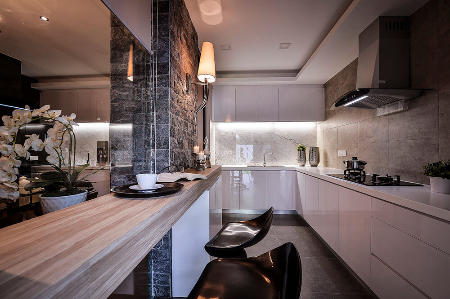
Taste and Textures: What Your Kitchen Worktop Says About Your Personality
Friday, November 20, 2020
Your kitchen worktop is the single most important decision you can make when installing a new kitchen. So choosing the right worktop surface is one of the most crucial decisions you'll make. Your kitchen worktop choice can say a lot about your taste in design, your lifestyle and even how seriously you take your cooking. So, which one are you?
1. WoodYou are: warm, tactile, earthy and very antibacterial. You're easily shaped and can adapt to accommodate even the trickiest environment. However you are prone to scratching and can dent easily but, if looked after properly, you will last a very long time and, like a vintage wine, will just get better with age. You require oiling every six months or so, which some say is high-maintenance, but this will only serve to bring out all your natural character.
 Designer: The Roof Studio
2. Marble
Designer: The Roof Studio
2. Marble
You are: cool, calm and very collected. Classically beautiful, you automatically catch the eye, adding understated glamour to any scheme. Like all great divas, you are quite high maintenance, needing a lot of care and attention to stay in tip-top condition. You scratch easily. A little porous, you soak up the red wine a little too easily, which can leave you looking tired, damaged and out of condition. While certainly not cheap, you can still punch above your weight when used in small doses, lifting a scheme as a stand-out feature on an island, say.
 Designer: FIX Design Solution
3. Concrete
Designer: FIX Design Solution
3. Concrete
You are: tough. But adaptable. You can, quite literally, be poured into any templated shape. You are more than a little bit ‘urban street' but beneath your hard, no-nonsense exterior lurks an honest charm borne out of your ability to withstand whatever life throws at you. You wear your knocks well, and can be easily repaired but may need treating with a sealant to protect you from nasty stains.
4. Stainless steelYou are: a true professional. Handy with a cleaver, you have no time to dilly dally searching round for a chopping board to protect your delicate surface. No matter. The scratches, dents and knocks you take on simply add to your patina of charm. Tough, hygienic, hard wearing and hard working, have you thought of applying for Masterchef?
 Designer: Luna Solutions
5. Granite
Designer: Luna Solutions
5. Granite
You: think you're hard enough? Resistant to all scratches, you rival old softie marble for classic beauty and are at your most stunning in polished black (the ebony to the ivory of white units). Although hard enough to even take direct chopping without so much as leaving a mark, you do have a weakness for lemon juice which can ruin your perfect surface. In fact all kinds of citrus are like kryptonite to you, so your owners can become a little obsessive about keeping you constantly buffed.
 Designer: Q1 Interior Concept
6. Laminate
You are: versatile, adaptable, affordable and, unless you were born in the 80s, full of surprises. You are now available in a huge array of colours and sophisticated surface finishes. Thanks to the latest printing technology, you are a great mimic who can take on the look of real stone, marble or a host of other natural matrials. You come into your own when accessorised – something as simple as a stainless steel trim or wood veneer edging can really add character and lift you from the mundane to the marvellous.
Designer: Q1 Interior Concept
6. Laminate
You are: versatile, adaptable, affordable and, unless you were born in the 80s, full of surprises. You are now available in a huge array of colours and sophisticated surface finishes. Thanks to the latest printing technology, you are a great mimic who can take on the look of real stone, marble or a host of other natural matrials. You come into your own when accessorised – something as simple as a stainless steel trim or wood veneer edging can really add character and lift you from the mundane to the marvellous.
 Designer: Global Elite Ventures
7. Man-made composite
Designer: Global Elite Ventures
7. Man-made composite
You are: sleek, modern, solid and always up to the beat. You have a modern, edgy name like Corian, Silestone or Zodiac, being one of the cool gang who are easily fabricated into one seamless whole. You may well come in a punchy bright or sugary pastel colour, but chances are you're effortlessly beautiful in a flat finish cream, putty, pure white or café latte shade. You are hygienic, easy to clean and recover well from set-backs with scratches and stains being easily polished out. Installation isn't easy, so you need careful handling, by a professional who knows what they're doing but that's because, hey, you're worth it...
 Designer: Zanotta Design & Renovation
Designer: Zanotta Design & Renovation
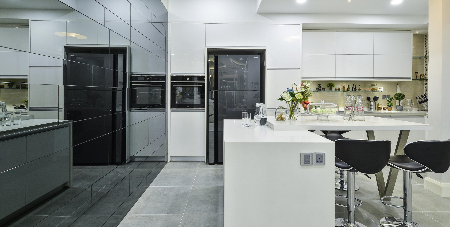
Sleek and Shiny: Pros and Cons of Using Reflective Kitchen Cabinets
Friday, November 20, 2020
Glossy cabinets in the kitchen are highly sought after, perhaps for the same reasons as lustrous minerals and polished baubles have been considered prized treasures since antiquity - a reflective surface imitates the world more accurately than any representational art form, while being nothing more than an otherwise meaningless object that has been polished smooth with effort, or a combination of time, pressure, and heat. If you happened across our analysis of materials commonly used in kitchen cabinets or countertops, and you have your heart set on updating your cooking space with glistening surfaces, you may be interested in taking a closer look at the advantages (and disadvantages) of reflective cabinets in the modern kitchen.
Smooth Surfaces
 Interior design by: Design Spirits
Interior design by: Design Spirits
While mirrored planes can be counted on to visually expand a space, most reflective surfaces are manufactured with a degree of smoothness that is measured in microns. This level of precision commonly entails an absence of texture in most materials, which can render a kitchen cold and aloof if large or seamless panes are applied without any discernible spacing to provide some semblance of texture. By applying reflective planes in a haphazard, brick-like configuration, the interior designer - Design Spirits provides this kitchen with both a visual expansion and a chaotic aesthetic element to contrast against the ordered lines of modern design.
Concealing Shade
 Interior design by: Hue Art Design
Interior design by: Hue Art Design
In addition to bearing little to no discernable texture, glossy cabinets will present greasy fingerprints more discernibly - in part, due to a characteristic imparting smooth planes with a “stickiness” (van der Waals forces), which attracts even the most microscopic of airborne particles and prominently displays light-disrupting dirt against a reflective surface. A slightly darker tint - as applied by Hue Art Design to the cabinets in this kitchen - will lessen the visual impact of dirt. Cleaning should be done periodically with a micro-fibre washcloth, to prevent scratches that could potentially add to the diffusion of light and result in slightly blurred reflections.
Intriguing Angles
Because mirrored surfaces reflect rather than absorb light, polished planes can be used to visually expand a space and provide unique perspectives that would not ordinarily be possible with matte surfaces. Designed by Zanotta, this kitchen utilises reflections to widen the scene and mystify the eye. Although partially obscured behind a projecting island, the polished doors on the lower cabinets present the entirety of the floor space to observers entering the kitchen - while the upper cabinets magnify the sunlight and warm yellow glows from the lighting fixtures.
Modern Circumstances
 Interior design by: Homlux Interior Furnishing
Interior design by: Homlux Interior Furnishing
The combination of space-expanding visual effects and typically narrow profiles make reflective planes one of the most indispensable ingredients of the modern urban home. Without the darkly-tinted reflected surfaces providing both visual expansion and contrast in this kitchen designed by Homlux Interior Furnishing, the narrow space may have otherwise appeared unbalanced with the abundance of stone, the extra height provided by the air-well, and the intense glow of the sun streaming in through the skylight.
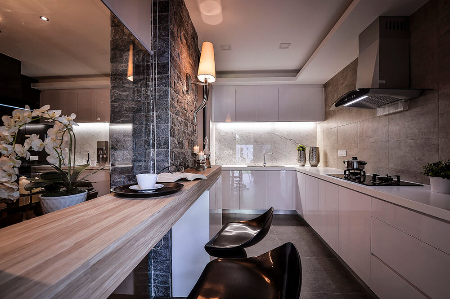
Taste and Textures: What Your Kitchen Worktop Says About Your Personality
Friday, November 20, 2020
Your kitchen worktop is the single most important decision you can make when installing a new kitchen. So choosing the right worktop surface is one of the most crucial decisions you'll make. Your kitchen worktop choice can say a lot about your taste in design, your lifestyle and even how seriously you take your cooking. So, which one are you?
1. WoodYou are: warm, tactile, earthy and very antibacterial. You're easily shaped and can adapt to accommodate even the trickiest environment. However you are prone to scratching and can dent easily but, if looked after properly, you will last a very long time and, like a vintage wine, will just get better with age. You require oiling every six months or so, which some say is high-maintenance, but this will only serve to bring out all your natural character.
 Designer: The Roof Studio
2. Marble
Designer: The Roof Studio
2. Marble
You are: cool, calm and very collected. Classically beautiful, you automatically catch the eye, adding understated glamour to any scheme. Like all great divas, you are quite high maintenance, needing a lot of care and attention to stay in tip-top condition. You scratch easily. A little porous, you soak up the red wine a little too easily, which can leave you looking tired, damaged and out of condition. While certainly not cheap, you can still punch above your weight when used in small doses, lifting a scheme as a stand-out feature on an island, say.
 Designer: FIX Design Solution
3. Concrete
Designer: FIX Design Solution
3. Concrete
You are: tough. But adaptable. You can, quite literally, be poured into any templated shape. You are more than a little bit ‘urban street' but beneath your hard, no-nonsense exterior lurks an honest charm borne out of your ability to withstand whatever life throws at you. You wear your knocks well, and can be easily repaired but may need treating with a sealant to protect you from nasty stains.
4. Stainless steelYou are: a true professional. Handy with a cleaver, you have no time to dilly dally searching round for a chopping board to protect your delicate surface. No matter. The scratches, dents and knocks you take on simply add to your patina of charm. Tough, hygienic, hard wearing and hard working, have you thought of applying for Masterchef?
 Designer: Luna Solutions
5. Granite
Designer: Luna Solutions
5. Granite
You: think you're hard enough? Resistant to all scratches, you rival old softie marble for classic beauty and are at your most stunning in polished black (the ebony to the ivory of white units). Although hard enough to even take direct chopping without so much as leaving a mark, you do have a weakness for lemon juice which can ruin your perfect surface. In fact all kinds of citrus are like kryptonite to you, so your owners can become a little obsessive about keeping you constantly buffed.
 Designer: Q1 Interior Concept
6. Laminate
You are: versatile, adaptable, affordable and, unless you were born in the 80s, full of surprises. You are now available in a huge array of colours and sophisticated surface finishes. Thanks to the latest printing technology, you are a great mimic who can take on the look of real stone, marble or a host of other natural matrials. You come into your own when accessorised – something as simple as a stainless steel trim or wood veneer edging can really add character and lift you from the mundane to the marvellous.
Designer: Q1 Interior Concept
6. Laminate
You are: versatile, adaptable, affordable and, unless you were born in the 80s, full of surprises. You are now available in a huge array of colours and sophisticated surface finishes. Thanks to the latest printing technology, you are a great mimic who can take on the look of real stone, marble or a host of other natural matrials. You come into your own when accessorised – something as simple as a stainless steel trim or wood veneer edging can really add character and lift you from the mundane to the marvellous.
 Designer: Global Elite Ventures
7. Man-made composite
Designer: Global Elite Ventures
7. Man-made composite
You are: sleek, modern, solid and always up to the beat. You have a modern, edgy name like Corian, Silestone or Zodiac, being one of the cool gang who are easily fabricated into one seamless whole. You may well come in a punchy bright or sugary pastel colour, but chances are you're effortlessly beautiful in a flat finish cream, putty, pure white or café latte shade. You are hygienic, easy to clean and recover well from set-backs with scratches and stains being easily polished out. Installation isn't easy, so you need careful handling, by a professional who knows what they're doing but that's because, hey, you're worth it...
 Designer: Zanotta Design & Renovation
Designer: Zanotta Design & Renovation
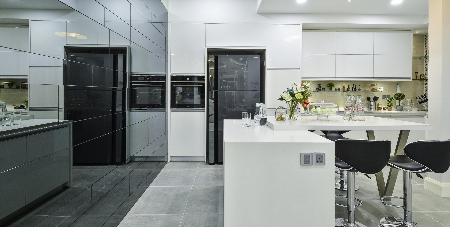
Sleek and Shiny: Pros and Cons of Using Reflective Kitchen Cabinets
Friday, November 20, 2020
Glossy cabinets in the kitchen are highly sought after, perhaps for the same reasons as lustrous minerals and polished baubles have been considered prized treasures since antiquity - a reflective surface imitates the world more accurately than any representational art form, while being nothing more than an otherwise meaningless object that has been polished smooth with effort, or a combination of time, pressure, and heat. If you happened across our analysis of materials commonly used in kitchen cabinets or countertops, and you have your heart set on updating your cooking space with glistening surfaces, you may be interested in taking a closer look at the advantages (and disadvantages) of reflective cabinets in the modern kitchen.
Smooth Surfaces
 Interior design by: Design Spirits
Interior design by: Design Spirits
While mirrored planes can be counted on to visually expand a space, most reflective surfaces are manufactured with a degree of smoothness that is measured in microns. This level of precision commonly entails an absence of texture in most materials, which can render a kitchen cold and aloof if large or seamless panes are applied without any discernible spacing to provide some semblance of texture. By applying reflective planes in a haphazard, brick-like configuration, the interior designer - Design Spirits provides this kitchen with both a visual expansion and a chaotic aesthetic element to contrast against the ordered lines of modern design.
Concealing Shade
 Interior design by: Hue Art Design
Interior design by: Hue Art Design
In addition to bearing little to no discernable texture, glossy cabinets will present greasy fingerprints more discernibly - in part, due to a characteristic imparting smooth planes with a “stickiness” (van der Waals forces), which attracts even the most microscopic of airborne particles and prominently displays light-disrupting dirt against a reflective surface. A slightly darker tint - as applied by Hue Art Design to the cabinets in this kitchen - will lessen the visual impact of dirt. Cleaning should be done periodically with a micro-fibre washcloth, to prevent scratches that could potentially add to the diffusion of light and result in slightly blurred reflections.
Intriguing Angles
Because mirrored surfaces reflect rather than absorb light, polished planes can be used to visually expand a space and provide unique perspectives that would not ordinarily be possible with matte surfaces. Designed by Zanotta, this kitchen utilises reflections to widen the scene and mystify the eye. Although partially obscured behind a projecting island, the polished doors on the lower cabinets present the entirety of the floor space to observers entering the kitchen - while the upper cabinets magnify the sunlight and warm yellow glows from the lighting fixtures.
Modern Circumstances
 Interior design by: Homlux Interior Furnishing
Interior design by: Homlux Interior Furnishing
The combination of space-expanding visual effects and typically narrow profiles make reflective planes one of the most indispensable ingredients of the modern urban home. Without the darkly-tinted reflected surfaces providing both visual expansion and contrast in this kitchen designed by Homlux Interior Furnishing, the narrow space may have otherwise appeared unbalanced with the abundance of stone, the extra height provided by the air-well, and the intense glow of the sun streaming in through the skylight.
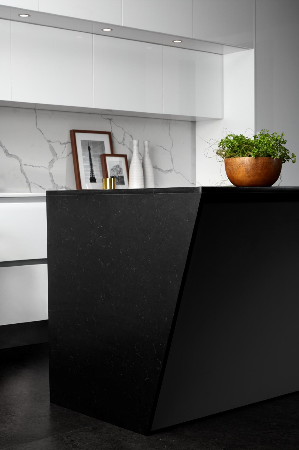
How to Choose the Correct Kitchen Finishes and Materials
Friday, November 20, 2020
Whether you are decorating for durability or for eye-pleasing aesthetics, there are a multitude of factors to consider when selecting materials and finishes for your kitchen.
 Interior design by: Signature Kitchen
Interior design by: Signature Kitchen
At first glance, a kitchen in the making may only evoke concerns over its final appearance, but there's to more to it than meets the eye. Materials and finishes play an important role as well when it comes to the countertops, cabinetry, paint and backsplash features. Whether your style is traditional, transitional, or modern, focus on an overall theme as one of the first steps to selecting your materials. Aside from colour, it's also important to consider tone and texture to create an overall design that does not appear visually flat when the project is completed.
Laminates
 Interior design by: Regal Violet
Interior design by: Regal Violet
Being made of highly-compressed layers of wood and fabric soaked in resins, laminates provide a greater range of possible shades - in addition to the aesthetic quality of natural wood, combined with the relative durability of plastic resins. Laminates of the past may have garnered a reputation for being susceptible to high humidity and temperatures, but recent developments in the refinement of plastics have resulted in more accessible and durable laminates that are less likely to peel with moisture and age.
Natural Stone
 Interior design by: IDS Interior
Interior design by: IDS Interior
The irreproducible shades and veins of quarried stone panels make for truly unique countertops that project an image of individuality and prosperity - but being a material acquired from natural sources, quarried stones of matching shades are notoriously difficult to acquire in consistent quantities, making planning and acquisition the most crucial stages in the renovation of a kitchen with stone surfaces. The workability of stone does not compare to the ease of working with wood however, as various types of stone have an inherent propensity to chip in response to impact or crack from vibrations - which entails uniform sizes of panels and finishing details such as edge cuts to be affected by an experienced craftsperson.
Wood
 Interior design by: Q1 Interior Concept
Interior design by: Q1 Interior Concept
Natural wood, especially those selectively harvested from managed plantations, represent an increasingly popular choice among the ecologically conscientious and anyone seeking to recreate a cooking space from a simpler time. Wood is the simplest material to work with, and some of us may be immediately drawn to materials such as reclaimed wood planks to bedeck a kitchen in country style, but the porosity and propensity to absorb water in even the densest of hardwoods is cause for caution. Despite the physical drawbacks, the occasional authentic wooden element makes for a dramatic and nuanced contrast when presented in conjunction with other materials such as stone or steel.
Tiles
 Interior design by: ST Concepts
Interior design by: ST Concepts
While cutting, shaping, and polishing natural stone by hand is an art unto itself, the use of ceramic or porcelain tiles, or even pre-cut stone pieces, make the aesthetics of stone more accessible. Modern tiles can be manufactured to mimic the shades and patterns of natural stone, or to introduce designed patterns and colours, often rolling out of industrial ovens with varieties of matte or glossy sheens already baked in. As they are manufactured materials, most tiles composed of ceramic or porcelain require little to no chemical treatment after installation - however, much like pre-cut stone tiles, ceramic and porcelain tiles must be bordered with grout to adhere the tiles and prevent them from impacting each other.
Stainless Steel
 Interior design by: Creative Steel
Interior design by: Creative Steel
Any commercial entity with its livelihood based on the preparation of food depends on a kitchen furnished with stainless steel surfaces. The accessibility, durability, and chemical resistance of steel are unmatched by all other materials - with the sole exception of quartz. High-gauge stainless steel is strong, yet thin enough to be easily workable, but countertops will show visible dents without a cushioning layer of hardwood to absorb impacts. Besides providing a reflective sheen that complements modern kitchens and visually expands compact spaces, stainless steel is a practical choice for countertops as it is able to withstand high temperatures without conducting heat away from the source.
Cement
 Interior design by: Homlux Interior Furnishing
Interior design by: Homlux Interior Furnishing
Where stone and tiles typically restrict designs to dimensions predetermined by suppliers and manufacturers, the use of cement to render surfaces opens the door on all kinds of creative expressions in post-industrial style. Much like natural stone, cement is susceptible to impact damage and has a porosity that must be addressed by the application of chemical treatments to prevent stains. Without a sealing coat, cement surfaces tend to appear matte when cured, with a tendency towards displaying unpredictable streaking of limescale when fully dried. Aged cement surfaces accumulate an irreproducible polish and characteristic patina over time, a feature that is warming and comforting to those seeking a vintage-industrial décor.
Engineered Quartz
 Interior design by: Turn Design
Interior design by: Turn Design
With engineered stone surfaces such as quartz, the shades and veins of natural stone are made more accessible with recent improvements in adhesives. Unlike naturally quarried stone, engineered quartz is non-porous and much more readily available - being composed of synthetic polymers and otherwise unused flecks from the same quarries supplying the world’s most recognizable types of marble. The majority of the blend being quartz - one of the Earth’s hardest minerals, the finished product is a surface that withstands more physical damage, chemicals, as well as fluctuations between temperature extremes, even when compared with the densest of natural stones. Consequently, it is also one of the most difficult materials to work with, limiting the supply and installation of this material to a select network of manufacturers and applicators.
Solid Surface
 Interior design by: Design Integra
Interior design by: Design Integra
Much like cement, solid surfaces can be seamlessly rendered in curved profiles while the material is still in its uncured slurry state. Unlike cement, solid surfaces are shaped at the point of manufacture much like quartz panels are, but their inherent workability permits shaping during installation and repairs by grinding or polishing. Being manufactured in a similar manner as quartz, the designs and shades of solid surfaces among the world’s various suppliers are highly varied - but while quartz can be identified as being composed of a single type of mineral, solid surfaces may be based on softer minerals, or contain a mixture of minerals to achieve a balance of aesthetics and workability.
Glass
 Interior design by: Homlux Interior Furnishing
Interior design by: Homlux Interior Furnishing
If the reflective quality of stainless steel seems to fall short of expectations, consider using glass on the backsplash, or to finish the fronts of cabinets instead. Whether opaque or transparent, glass adds a delicate layer of modern elegance to kitchens - especially when used in conjunction with other disparate materials such as wood, stone, or steel. Glass panes can also be used to protect porous materials such as wood or stone from moisture and stains by being fixed over the more absorbent materials. The aesthetic qualities of glass do come with a rather widely-understood caveat: being a crystalline structure locked in a stable state by heat and pressure, glass is susceptible to impact damage and extreme temperature fluctuations -necessitating caution in its use on surfaces where heavy objects such as pots and pans are likely to land with some force.
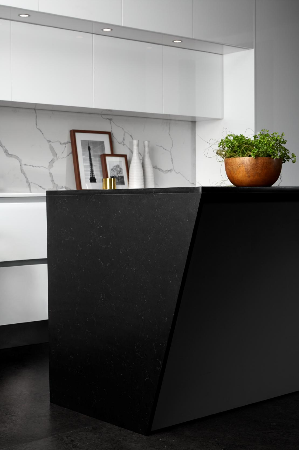
How to Choose the Correct Kitchen Finishes and Materials
Friday, November 20, 2020
Whether you are decorating for durability or for eye-pleasing aesthetics, there are a multitude of factors to consider when selecting materials and finishes for your kitchen.
 Interior design by: Signature Kitchen
Interior design by: Signature Kitchen
At first glance, a kitchen in the making may only evoke concerns over its final appearance, but there's to more to it than meets the eye. Materials and finishes play an important role as well when it comes to the countertops, cabinetry, paint and backsplash features. Whether your style is traditional, transitional, or modern, focus on an overall theme as one of the first steps to selecting your materials. Aside from colour, it's also important to consider tone and texture to create an overall design that does not appear visually flat when the project is completed.
Laminates
 Interior design by: Regal Violet
Interior design by: Regal Violet
Being made of highly-compressed layers of wood and fabric soaked in resins, laminates provide a greater range of possible shades - in addition to the aesthetic quality of natural wood, combined with the relative durability of plastic resins. Laminates of the past may have garnered a reputation for being susceptible to high humidity and temperatures, but recent developments in the refinement of plastics have resulted in more accessible and durable laminates that are less likely to peel with moisture and age.
Natural Stone
 Interior design by: IDS Interior
Interior design by: IDS Interior
The irreproducible shades and veins of quarried stone panels make for truly unique countertops that project an image of individuality and prosperity - but being a material acquired from natural sources, quarried stones of matching shades are notoriously difficult to acquire in consistent quantities, making planning and acquisition the most crucial stages in the renovation of a kitchen with stone surfaces. The workability of stone does not compare to the ease of working with wood however, as various types of stone have an inherent propensity to chip in response to impact or crack from vibrations - which entails uniform sizes of panels and finishing details such as edge cuts to be affected by an experienced craftsperson.
Wood
 Interior design by: Q1 Interior Concept
Interior design by: Q1 Interior Concept
Natural wood, especially those selectively harvested from managed plantations, represent an increasingly popular choice among the ecologically conscientious and anyone seeking to recreate a cooking space from a simpler time. Wood is the simplest material to work with, and some of us may be immediately drawn to materials such as reclaimed wood planks to bedeck a kitchen in country style, but the porosity and propensity to absorb water in even the densest of hardwoods is cause for caution. Despite the physical drawbacks, the occasional authentic wooden element makes for a dramatic and nuanced contrast when presented in conjunction with other materials such as stone or steel.
Tiles
 Interior design by: ST Concepts
Interior design by: ST Concepts
While cutting, shaping, and polishing natural stone by hand is an art unto itself, the use of ceramic or porcelain tiles, or even pre-cut stone pieces, make the aesthetics of stone more accessible. Modern tiles can be manufactured to mimic the shades and patterns of natural stone, or to introduce designed patterns and colours, often rolling out of industrial ovens with varieties of matte or glossy sheens already baked in. As they are manufactured materials, most tiles composed of ceramic or porcelain require little to no chemical treatment after installation - however, much like pre-cut stone tiles, ceramic and porcelain tiles must be bordered with grout to adhere the tiles and prevent them from impacting each other.
Stainless Steel
 Interior design by: Creative Steel
Interior design by: Creative Steel
Any commercial entity with its livelihood based on the preparation of food depends on a kitchen furnished with stainless steel surfaces. The accessibility, durability, and chemical resistance of steel are unmatched by all other materials - with the sole exception of quartz. High-gauge stainless steel is strong, yet thin enough to be easily workable, but countertops will show visible dents without a cushioning layer of hardwood to absorb impacts. Besides providing a reflective sheen that complements modern kitchens and visually expands compact spaces, stainless steel is a practical choice for countertops as it is able to withstand high temperatures without conducting heat away from the source.
Cement
 Interior design by: Homlux Interior Furnishing
Interior design by: Homlux Interior Furnishing
Where stone and tiles typically restrict designs to dimensions predetermined by suppliers and manufacturers, the use of cement to render surfaces opens the door on all kinds of creative expressions in post-industrial style. Much like natural stone, cement is susceptible to impact damage and has a porosity that must be addressed by the application of chemical treatments to prevent stains. Without a sealing coat, cement surfaces tend to appear matte when cured, with a tendency towards displaying unpredictable streaking of limescale when fully dried. Aged cement surfaces accumulate an irreproducible polish and characteristic patina over time, a feature that is warming and comforting to those seeking a vintage-industrial décor.
Engineered Quartz
 Interior design by: Turn Design
Interior design by: Turn Design
With engineered stone surfaces such as quartz, the shades and veins of natural stone are made more accessible with recent improvements in adhesives. Unlike naturally quarried stone, engineered quartz is non-porous and much more readily available - being composed of synthetic polymers and otherwise unused flecks from the same quarries supplying the world’s most recognizable types of marble. The majority of the blend being quartz - one of the Earth’s hardest minerals, the finished product is a surface that withstands more physical damage, chemicals, as well as fluctuations between temperature extremes, even when compared with the densest of natural stones. Consequently, it is also one of the most difficult materials to work with, limiting the supply and installation of this material to a select network of manufacturers and applicators.
Solid Surface
 Interior design by: Design Integra
Interior design by: Design Integra
Much like cement, solid surfaces can be seamlessly rendered in curved profiles while the material is still in its uncured slurry state. Unlike cement, solid surfaces are shaped at the point of manufacture much like quartz panels are, but their inherent workability permits shaping during installation and repairs by grinding or polishing. Being manufactured in a similar manner as quartz, the designs and shades of solid surfaces among the world’s various suppliers are highly varied - but while quartz can be identified as being composed of a single type of mineral, solid surfaces may be based on softer minerals, or contain a mixture of minerals to achieve a balance of aesthetics and workability.
Glass
 Interior design by: Homlux Interior Furnishing
Interior design by: Homlux Interior Furnishing
If the reflective quality of stainless steel seems to fall short of expectations, consider using glass on the backsplash, or to finish the fronts of cabinets instead. Whether opaque or transparent, glass adds a delicate layer of modern elegance to kitchens - especially when used in conjunction with other disparate materials such as wood, stone, or steel. Glass panes can also be used to protect porous materials such as wood or stone from moisture and stains by being fixed over the more absorbent materials. The aesthetic qualities of glass do come with a rather widely-understood caveat: being a crystalline structure locked in a stable state by heat and pressure, glass is susceptible to impact damage and extreme temperature fluctuations -necessitating caution in its use on surfaces where heavy objects such as pots and pans are likely to land with some force.

Choice Cabinetry: 6 Kitchen Cabinet Design Ideas That Totally Transform Your Cookspaces
Friday, November 20, 2020
As we pointed out previously in our guide on colours for the kitchen, it doesn't always have to be in white - although it usually is. This time around we take a look at a range of approaches to cabinets that will not only provide your kitchen with a different shade - but an altogether unique appearance as well.
1. Wood Wood is coming back to our homes, thanks in part to the shifting mood regarding global climate change, we have been seeing a return of both laminates and hardwood in cabinetry bearing shades of reclaimed or varnished wood to complement rustic and modern kitchens alike. The homage to this natural material does not necessarily need to be overt - even when constructed from completely synthetic materials, cabinets can be decorated with cuts or classically-inspired detailing to imply that some carpentry was involved.
 Designer: Nu Infinity
Designer: Nu Infinity
2. Concrete Grey Exposed concrete is another material spotted making a resurgence, helping to create a masculine ambiance when paired with minimalist furnishings in post-industrial properties. While the use of actual concrete on cabinet doors would be impractical, the characteristic tone and blemishes of cement can be reproduced with a few coats of thinned grey paint on unvarnished wood to complement an industrial decor.
 Designer: X-Two Concept
Designer: X-Two Concept
3. Glossy / Reflective Glossy cabinetry is not a new component of 21st century kitchens, having been in heavy use since the processes behind laminates have expanded to produce a wide range of finishes. Give that sheen a purpose by selecting a material with an ultra-glossy or reflective finish for your cabinets, to visually enlarge the space and bestow your kitchen with a palatable elegance.
 Designer: Zanotta Studio Design and Renovation
Designer: Zanotta Studio Design and Renovation
4. Transparent Adaptable to a wide range of styles and colours, using completely transparent or frosted glass doors on your cabinets immediately turns your storage into display cases that can be completed with luxurious facility when fitted with internal lighting.
 Designer: Space Living
Designer: Space Living
5. Metallic We've mentioned before that serious chefs seem to gravitate towards stainless steel countertops, and we are just as certain about their receptiveness to steel cabinetry. The clean and durable look and feel of steel lends itself well to post-industrial interiors, providing a greater measure of modern elegance than cement in the seamless welded joints and folded laps of steel sheeting.
 Designer: Archicentre
Designer: Archicentre
6. Underfoot Lighting We have all probably seen the use of LED strips embedded beneath upper cabinets to illuminate countertops, but you probably have not seen that same form of fixture being used beneath lower cabinets to light the floor. More mood lighting than task lighting, these LED strips introduce a dose of glam into what would be otherwise bland spaces.
 Designer: Jashen Interior Design
Click here to see more kitchens!
Designer: Jashen Interior Design
Click here to see more kitchens!
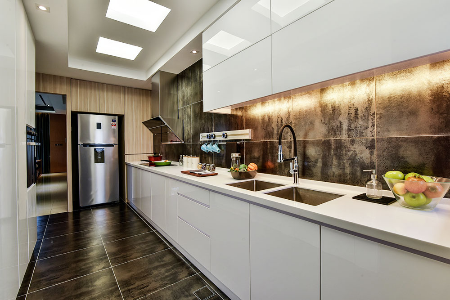
Counter Balance: How to Choose the Best Kitchen Countertop Surfaces
Friday, November 20, 2020
With all the various materials available for kitchen countertops, we figured you could do with some pointers on how to choose the most appropriate surface to suit your needs and your décor, so we gathered our team of experts and let them loose in our kitchens to help us put together what has turned out to be the internet's most definitive guide on materials for kitchen countertop surfaces.
Kitchen countertops can be formed out of completely natural or synthetic materials, or even some combination of both - all presenting different challenges. Your choice of material may be dependent on its colour and appearance, or what that selection says about your personality - but a forward-planning homeowner should also consider cost, availability, workability, durability, and maintenance needs before settling on a choice of a particular material.
 Designer: Craftsmen Valley
Designer: Craftsmen Valley
First of all, before settling on a particular material for surfaces that may become permanent fixtures in your kitchen, one should view and feel samples or mock-ups in person rather than depending on images to be accurately representative - as camera lenses, photo filters, and imaging algorithms sometimes do unpredictable things when reproducing real-life examples.
Laminates Since Formica® was popularized in Europe in the 1950s, laminates have made reappearances in the 1970s and in modern times to affect vintage interiors. Being a material largely composed of sheets of textile or fabric soaked in plastic resins, laminates are easily the most affordable material for kitchen surfaces. Various colours and textures are easily attained with the addition of pigments or thin sheets of natural materials into the compositions, meaning that the availability of laminates is likely the highest among all other materials. However, laminates will fade in direct sunlight and despite their highly synthetic composition, they do not stand up well to excessive moisture or corrosive chemicals such as some cleaning fluids. Although reputed to be susceptible to scratches and to scorching at high temperatures, laminates using modern formulations of resins have greatly increased their resistance to burns and scratches, as well as other forms of wear and tear in recent years.

Designer: IKEA
Wood The warming tones and grains of wood are ideal for creating a rustic or country atmosphere, working equally well when set within modern décors as accents. Wood is simple to work with, a fact that any high school student who has been subjected to woodworking classes can attest to. Wood is also highly workable, enabling curved surfaces that cannot be matched by the majority of engineered materials. Due to their natural origins and versatility in a wide range of interiors, wood is highly priced and limited in availability, meaning that finding large amounts of matching tones and grains may be a challenge. This much sought-after natural material requires a greater degree of care to maintain on account of its relative softness and porosity: wood is easily scratched, although the damage can be removed with sandpaper, but water is perhaps a wooden surface's worst enemy - requiring coats of varnish and regular doses of wood oil to seal gaps and prevent water from seeping in, which would result in the wood rotting from the inside and smelling of a wet forest.
 Designer: Casa Indah Design
Designer: Casa Indah Design
Concrete Countertops composed of cement and aggregate have been spotted making a resurgence in modern interiors ranging from minimalist to industrial. Relatively low in cost and high in availability, concrete surfaces can be customized in a wide variety of ways. Due to their initial liquid-like slurry state, concrete surfaces can be dyed with pigments, trowelled to form seamless curves, stamped with designs, pressed for marbled veins, or polished to a smooth finish. Concrete surfaces are highly resistant to scratches when fully set, but care should still be taken around this material as it can warp or even crack with extreme fluctuations in temperature, it also discolours with moisture and is susceptible to etching by mild acidic solutions. Due to their porosity when cured, concrete surfaces must be maintained with coats of sealer regularly applied every few months to prevent staining.
 Designer: Nevermore Design
Designer: Nevermore Design
Stone Natural stone such as granite, and softer stone such as marble, limestone, or soapstone have been popular in the last few decades, due in part to their timeless beauty and unique patterns. Natural stone has to be quarried from the handful of locations around the world known to be fortunate enough to have these beautiful materials thrust through the crust - as a result, the cost of acquisition is relatively high and dependant on the stone's origin and appearance, with availability being almost never guaranteed. Granite is the most durable, but like the rest of the popular stone materials, their natural porosity requires regular maintenance in the form of sealing coats.
 Designer: FIX Design Solutions
Designer: FIX Design Solutions
Solid Surface Typically composed of two-thirds mineral dust and one-third polymer resins, solid surfaces are perhaps the most versatile of all stone-based materials. Solid surfaces can be dyed with pigments and shaped into seamless curves in the same manner as concrete. Due to their composition being based on a by-product of quarrying activities, solid surface materials entail a reduced environmental impact, and they are relatively affordable in comparison to natural stone. Softer than granite, solid surfaces can be scratched - but the damage can be removed by sanding and polishing. Unlike natural stone, solid surfaces are non-porous and do not require sealing at the manufacturing level and little to no maintenance. Availability and installation may be an issue with this material, as the ownership of the high-technology facilities required to manufacture and install solid surface countertops are restricted to a few select entities.
 Designer: Havana Konzept
Designer: Havana Konzept
Quartz On the most durable end of the scale is quartz - often called engineered stone, which is composed of crushed stone that would otherwise have been discarded but is instead mixed with pigments and polymer resins to bind them together into the toughest possible material for your countertop. Quartz has been often touted as the material most resistant to scratches and heat, due to the high proportion of stone relative to synthetic materials in the composition of kitchen countertops. The dependence on unwanted stone rather than quarrying new materials makes quartz a more eco-friendly choice when compared against natural stone. The challenges with quartz are few, but considerable in importance: due to their manufacture being dependant on supplies of crushed stone, their cost is likely the highest among all other materials, availability in particular colours or styles may be limited, and by virtue of their hardness - quartz is the heaviest and most difficult material to install without professional assistance.
 Designer: Caesarstone
Designer: Caesarstone
Steel The preferred choice of serious chefs everywhere, steel stands up best to scratches and chemicals - especially when provided with a protective coating composed of polymers or carbon molecules. Various grades of steel are churned out from all corners of the globe, making this material one of the most available - but the heavy equipment and high level of expertise required to work steel into the forms necessary for kitchen countertops makes for relatively difficult and costly custom installations.
 Designer: Officine Gullo
Designer: Officine Gullo
Detailing and Finishes Once you have juggled all the various considerations that go into selecting the material for your kitchen countertop, its appearance, cost, availability, workability, durability, and maintenance needs - you cannot forgo putting some thought into the kind of detailing and finishes you want. Consider details such as bevels or curves to soften hard edges, and polishing the surface smooth for a reflective sheen, or dull for a matte finish to downplay the surface's prominence. You could even take things to the next level by mixing materials together: think a wood block framed in stone, for example.
Click here to see some more kitchens!




